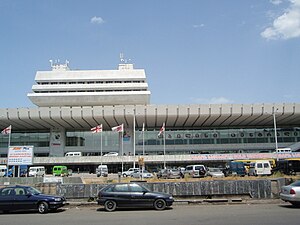Tbilisi railway station
Tbilisi | |
|---|---|
| Georgian Railway terminal | |
 | |
| General information | |
| Location | Tbilisi, Georgia |
| Coordinates | 41°43′15″N 44°47′58″E / 41.720953°N 44.799339°E |
| Owned by | Georgian Railway |
| Construction | |
| Parking | yes |
| History | |
| Opened | 1872 |
| Electrified | yes |
Tbilisi Railway station is a railway station located in Tbilisi, Georgia. Originally built in 1872, Tbilisi Railway station has undergone various architectural transformations, and currently serves as a combined railway station and shopping mall.
History

Tbilisi Railway station is the central railway station of Tbilisi with an adjacent shopping mall. The first central station in Tbilisi was built in 1872, with trains to the black sea port of Poti. In the 1940 the building was demolished and replaced with a building in the style of the Stalinist architecture. In the early 1980s the 1940s building was demolished and replaced by a building in the style of the Brutalist architecture. The architects Bairamashvili, Kavlashvili, G. Shavdia and Jibladze won a State Prize for their work in 1992. In 2010 the station was rehabilitated and transformed into a combined railway station and shopping mall. The transformation was designed by Zwarts & Jansma architects.
Future
The direct Tbilisi crossing railroad line will be replaced by a bypass connection north of Tbilisi in the coming years. The Tbilisi central station will be closed and stay a shopping mall. It not more served by passenger trains, existing infrastructure will be dismantled.
Instead of a central station the Didube station in the east and the Navtlugi station in the northwest of Tbilisi become dead-end stations and were just served by passenger trains. Because of this a throughout connection for passenger trains and direct passenger transfers are no more possible in future. Instead of the expected reduction of environmental and traffic problems the axing will cause more traffic problems. Because the public transport and underground transport system of the capital is optimized for the central station. Although argued otherwise by the American consulting firm Booz Allen Hamilton, the project is therefore very much disputed by Western European transportation specialists and railway companies.[1][2]
See also
References
- ^ "Georgian Railway - Tbilisi Railway Bypass Project" (PDF). Georgian Railway LLC. Retrieved 2011-02-04.
- ^ Georgische Eisenbahn, Retrieved 2011-02-04[better source needed]
